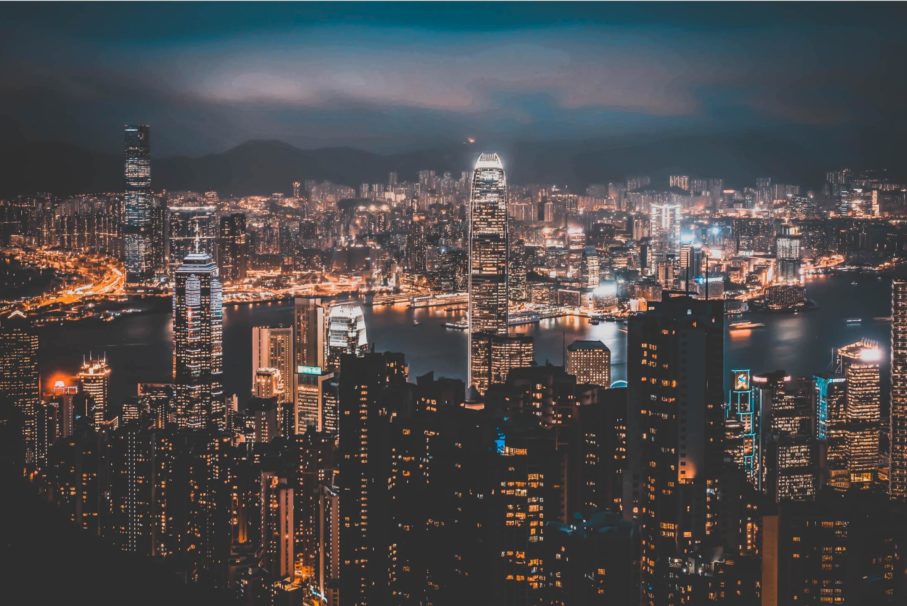
Hong Kong at night
This year has reminded us ‘what can happen when you’re busy making other plans.’ Now, as governments promote major infrastructure projects to revive the architectural and construction industries, it is essential that world cities do not lose sight of design excellence.
The eyes of the world have been on Hong Kong recently, and much sympathy has been expressed as political and social tensions have risen. For first-time visitors, Hong Kong’s density is itself a physical and existential experience ‒ an astonishing 7.5 million people live within just 1,104 square kilometres. Constrained by its otherwise beautiful topography – jagged mountains and spectacular coastlines mean buildable land is scarce – it’s no surprise that the city features the most skyscrapers in the world.
Hong Kong’s many individual landmark buildings, including the HSBC Building (Norman Foster), Bank of China Tower (I.M. PEI), West Kowloon Cultural District (Herzog and de Meuron) and Hong Kong International Airport, are much-admired icons. But with development becoming increasingly frenetic, the risk grows that design excellence will be compromised.
So how can world cities such as Hong Kong keep design excellence as a priority?
As Malcolm Reading recently discussed in Demystifying Competitions, the 8th Curatorial Conversations webinar, organised as part of Hong Kong’s Biennale of Urbanism\Architecture, design competitions are a sound place to start.
Competitions offer numerous benefits: they save a client time and money; allow stakeholder and public engagement; attract international expertise; and spark innovative, out-of-the-box thinking. Above all, they add value – and provide choice.
Embedding design competitions
The city of Sydney has fully embraced design competitions, embedding the process into its planning regulations – a model that world cities such as Hong Kong could follow.
Since 2000, planning rules in Sydney have ensured that buildings of a certain height, area, or capital value are procured through a competitive design process. Incentives sweeten the deal for developers: by engaging in a competition, the city will grant them up to 10 per cent additional floor space or building height.
This is a clever concept – an attractive proposal for developers, and a means to incentivise and energise architects – all while costing the city nothing. Recent competitions have resulted in a city with an abundance of innovative, attractive, award-winning design.
Embracing place holistically
By embedding competitions into planning processes, Sydney considered the city’s needs as a whole and looked at how to deliver an integrated public realm. For, where design excellence is prioritised, individual projects can’t be viewed in isolation – instead, projects need to be considered within their wider urban context.
One of MRC’s previous competitions, the Illuminated River, sought an architect and artist combination to light an extended sequence of Central London’s bridges. Instead of regarding the lighting of each in isolation, designers were asked to come up with a masterplan for the full series of bridges.
The winning team, New York-based artist Leo Villareal, working with project architects Lifschutz Davidson Sandilands, will create a dazzling art installation which, when complete, is expected to include 14 bridges, making it the longest public art commission in the world. The new light installations on four crossings – Southwark Bridge, the Millennium Bridge, Cannon Street Railway Bridge and London Bridge – have already been completed, encouraging Londoners to enjoy their river and riverside at night.
By considering the series of bridges as an entity, the project will transform the River Thames into a ‘ribbon of light’ that enhances and celebrates London as a whole, reflecting the city’s global ambition and creativity, all whilst serving a practical purpose: making the public realm around the bridges safe, inclusive and accessible.
The creativity released by competitions means that they are an excellent choice for iconic or legacy projects. Competitions can surprise in the most delightful ways: unlocking options that clients may not have considered, and solutions to problems previously unidentified. Additionally, the competition process allows clients to scrupulously refine the project brief.
The future of design excellence in Hong Kong
Hong Kong’s architects are already beginning to consider city-wide projects analogous to the Illuminated River. Designing Hong Kong, a not-for-profit organisation devoted to promoting good design, high quality of life, and sustainability, has recently proposed the creation of the Island Coastal Trail, a 65-kilometre hiking and cycling route around Hong Kong Island.
Despite being encircled with over 700 kilometres of beautiful shoreline, Hong Kongers’ access to the coast is limited to secluded beaches or parks, and it is at present difficult, if not impossible, to walk directly around the island.
In the past, various government bodies and councils have attempted to make the coastline more pedestrian-friendly, however work has been piecemeal, with different sections of the coast considered individually. No one has considered the island as a whole – until now. Designing Hong Kong has identified 18 possible projects to link waterfronts and communities and make the whole coastline accessible.
At the moment the Island Coastal Trail is hypothetical, and Designing Hong Kong will have to lobby various government departments to get the job done. However, if the project goes ahead, a design competition for the trail and its viewpoints would be an exciting initiative, attracting top-tier talent and leaving the city a more beautiful and friendly place.
If you didn’t get a chance to watch Curatorial Conversations #8: De-mystifying Competitions live, a recording can be found here.

